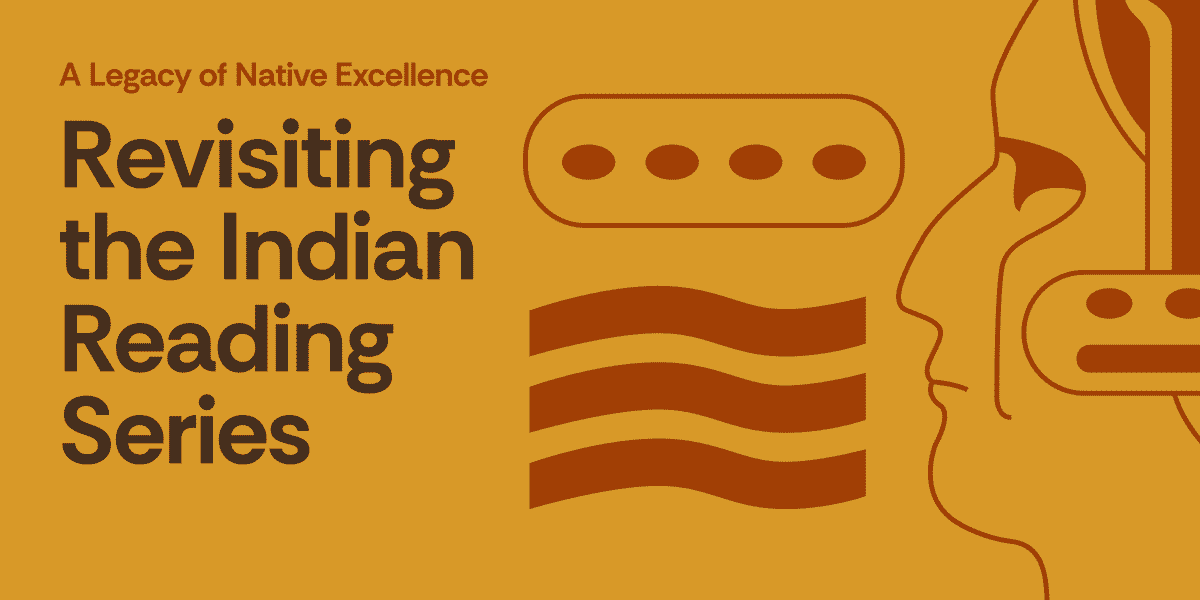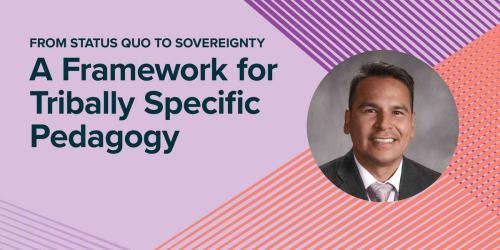A Legacy of Native Excellence: Revisiting the Indian Reading Series

There are few educational resources that remain relevant a half-century after they were developed. The Indian Reading Series is one.
Although long out of print, Education Northwest maintains the Indian Reading Series website that includes all 140 stories, four teacher manuals (grades K–3, 4, 5, and 6), and nine full lesson plans. They’re free to download, and there’s nothing quite like them.
Developed between 1972 and 1983, the series involved nearly two dozen Tribes, from 17 different reservation communities, across four states (Idaho, Montana, Oregon, and Washington). The project was funded by a five-year grant from the U.S. Department of Education’s then-new Office of Educational Research and Improvement (now the Institute of Education Sciences), while a second five-year federal grant focused on evaluating the implementation of the series and studying its impact on Native student engagement and reading outcomes.
The series remains a popular resource on our website, and our Native Education team has first-hand evidence that the materials are still being used in classrooms and have informed current Tribally focused and state-led curriculum development efforts.
This wasn’t about people from outside the community telling us what we needed and how we should address it. This was about Indian people saying, ‘Here are the challenges we’re seeing, and we’re looking for a partner who can help us address those challenges in a way that is culturally appropriate and supports our self-determination.
Based on this continued relevance, we gave the webpage a long-overdue redesign this past year, and Native American Heritage Month offers a great opportunity to take a deeper look at how it was created and why it has stood the test of time. To do so, we spoke with a few former members of the team that worked on the Indian Reading Series or served on its policy board. Their consensus: The series remains relevant because it was “done right.” Here’s what they mean.
Responding to Native-identified Needs
The spark for the project was a request from the Affiliated Tribes of Northwest Indians for assistance from the Northwest Regional Educational Laboratory (now Education Northwest) in 1971. Tribal leaders and educators from across the region had identified four primary concerns:
- Native students had lower than average reading scores, particularly in comprehension and fluency, which became more pronounced as academic vocabulary became more complex
- There was often a lack of culturally relevant reading and language arts materials provided in the classroom for Native students
- Due to cultural conflicts, low academic scores, and the lack of culturally relevant materials, many Native students struggled to maintain a positive self-image
- Most classroom teachers had little knowledge or understanding of Native students’ cultural backgrounds and needs
“The fact that it came from within the Indigenous community was essential,” said Robin Butterfield (Winnebago/Chippewa), who worked on the project early in her 40-plus year career in education and went on to serve as president of the National Indian Education Association. “This wasn’t about people from outside the community telling us what we needed and how we should address it. This was about Indian people saying, ‘Here are the challenges we’re seeing, and we’re looking for a partner who can help us address those challenges in a way that is culturally appropriate and supports our self-determination.’”
Establishing a Native-led Team
The Indian Reading Series project was led by Joe Coburn (Klamath Tribes), the director of Indian reading and language development at Northwest Regional Educational Laboratory at the time. Coburn hired Rudy Clements (Confederated Tribes of Warm Springs) to help manage the project and recruited a small team of mostly Native staff members.
By all accounts, Coburn was the driving force. “Joe had a reputation across the region,” said Butterfield. “He was hilarious and really smart, and he had this vision for creating something that did not exist and for doing it with integrity.”
Joe had a gift for people. He would put people at ease, get them laughing, and then he’d make his ask. People couldn’t say no. He won over everybody.
For Coburn, that meant the stories had to be authentic and the entire project had to be rigorous. He had seen two recent projects that were similar in intention and had found both lacking. The Indian Reading Series would be different. It would be academically challenging, grade-level appropriate, culturally authentic and engaging, and rooted in a deep understanding of the research into why Native students were struggling.
According to team members, one of Coburn’s frequent sayings at the time was “We’re not doing a Dick-and-Jane with feathers.”
To undertake the project, Coburn would draw on relationships that went back to his youth as a student at Chemawa Indian School, a boarding school near Salem, Oregon, that enrolls Native students from across the Northwest and beyond. Later, after earning his doctorate, he worked for the Blackfeet Tribe in Browning, Montana, where he developed an even broader network of relationships across Indian Country. These connections and the trust and good will he had developed would prove to be invaluable.
“Joe had a gift for people,” said Pat Badnin, who served as the graphic designer on the Indian Reading Series. “He would put people at ease, get them laughing, and then he’d make his ask. People couldn’t say no. He won over everybody.”
One of those people was Clements, who had a long history of working in Tribal government. “Where Joe was the visionary and the relationship builder,” said Badnin, “Rudy was focused on the day-to-day. He could really get things done. Together, they were a dynamic duo.”
Affirming Tribal Self-determination
The first thing Coburn did after procuring the original grant was establish a policy board consisting of Indian Education directors and other Tribal education leaders from across the four-state region. These were very well-known and well-respected educators with deep connections to their Tribes and to Native communities across the Northwest. There were not many people who could have convened that group besides Coburn.
The project team worked with the policy board to establish guidelines that emphasized Tribal self-determination. Each Tribe would choose the stories it would share and the Tribal elders who would tell them. In addition, most of the artwork would be provided by students from the Tribes and then worked into the overall design by Badnin. Individual Tribal curriculum committees would have final say on all materials and—in an agreement almost unheard of at the time—each Tribe would hold final copyright of its contributions.
In addition to the policy board, the project team convened three regional curriculum teams based on geographical location: coast, plateau, and plains. Each team included representatives from multiple Tribes in that region, and these representatives then reported back to their individual Tribal curriculum committees. The intent was to share information and resources, establish broad themes in which the stories could be grouped, and coordinate efforts, while also maintaining each Tribe’s control over its contributions.
From a project management standpoint, it may have been easier to take a more centralized approach, such as a single committee that chose the themes and stories and controlled final decisions about content. This was never an option. From the beginning, the project team and policy board were committed to a culturally appropriate Indigenous approach, no matter how challenging it might be to coordinate.
And challenging it was. Most Native American Tribes have cultural traditions and social expectations around storytelling that go back since time immemorial. This includes what stories can be told, who can tell them, and at what time of year. In addition, many of the stories were told in a Tribe’s heritage language and required translation. All of this had to be worked out, Tribe by Tribe, story by story. For Coburn and the project team, there was no other way to “do it right.”
Supporting Implementation
Gathering all 140 stories and the accompanying artwork was an incredible accomplishment. If the project team had stopped there, the series would still be worth using in the classroom 50 years later: The stories are still engaging, and the artwork is wonderfully evocative of its era. But they did not stop there.
It’s not just the stories and the artwork. There is background information to provide cultural context, there are activity cards, and there’s a lot of information about how to integrate the stories into your educational program.
“Most cultural reading series of this type did not have teacher guides to help with implementation,” said Butterfield. “They did not undergo extensive field testing. They did not have readability checks. The Indian Reading Series had all of that, and it’s another key to its success and longevity.”
Ultimately, the series would undergo field testing in nearly 100 classrooms across the region before it was published, and every story in the series would get an in-classroom readability check. This involved Tribal elders reading the stories to children, with researchers observing, to ensure the stories were written at the appropriate grade level.
In addition to these quality assurance measures, the project team developed the four teacher manuals, nine full lesson plans, and other supplemental materials.
“It’s not just the stories and the artwork,” said Butterfield. “There is background information to provide cultural context, there are activity cards, and there’s a lot of information about how to integrate the stories into your educational program.”
Norrine Smokey-Smith (Washoe Tribe of Nevada and California) first engaged with the Indian Reading Series while teaching summer school on the Grand Ronde Reservation. “These were prototypes,” she said. “This was part of the field testing. But you could tell that they were very high-interest stories that engaged the kids, and you could tell that they had already done a lot of work to support implementation.”
Smokey-Smith would go on to join the Indian Reading Series policy board and would eventually become Indian Education director at Portland Public Schools. Over the years she helped promote the series at education conferences and through personal networking.
“One key to its success is flexibility,” she said. “I used the materials in many different contexts, from one-on-one tutoring with Native students to supplemental curriculum in the classroom to full lessons based on the stories. The teacher has a lot of freedom as to how they want to engage with the materials. It’s open to their creativity and their understanding of their students.”
Building a Research Base
The final piece of the Indian Reading Series’ legacy is not as easy to see unless you’re an educational researcher. Coburn was an early proponent of taking a culturally based approach to educating Indigenous students and of advocating for Native self-determination in education.
In this, he was deeply influenced by the work of William Demmert and others who had attended the “First Convocation of American Indian Scholars” held at Princeton University in March 1970, only two years before the Indian Reading Series project began. This gathering sparked a new movement in Indian Education and led directly to the formation of the National Indian Education Association.
Coburn viewed the Indian Reading Series not only as an opportunity to create culturally relevant reading and language arts materials specifically designed for Native students (thereby responding to the need identified by the Affiliated Tribes of Northwest Indians), but also as an opportunity to help build a research base to support this new movement.
Using the second five-year federal grant, Coburn established the Pacific Northwest Indian Reading and Language Development Program, which later evolved into the Effective Practices in Indian Education Program. Through these programs he funded multiple research studies to examine how the Indian Reading Series was implemented and its preliminary impact on Native student outcomes. This included three primary monographs, one full-length study, and several shorter studies.
One study involved 12 Tribal schools in four states and included extensive classroom observations to measure the impact of culturally relevant content (stories from the reading series) on Native student engagement. All 12 schools showed positive impact.
Together, these studies represent some of the earliest rigorous research on the topic of culturally based education for Native students.
Carrying it Forward
Robey Clark (Blackfeet Tribe) was in his late 20s, just out of graduate school, and back home in Browning contemplating an uncertain future when Coburn recruited him for the Indian Reading Series project.
The Indian Reading Series paved the way for the kind of Tribal curriculum projects we’re seeing today and the increased focus on teaching Native children in ways that help them build connection and pride in their identity.
“The whole thing was quixotic in nature,” said Clark “The idea that we were going to gather all these Tribes together, get their full involvement, get Tribal elders to tell the stories, use Native artists—it was idealistic and maybe a little crazy. It had never been done before. But Joe just jumped in and put it together on the fly. Every problem that arose, he dealt with it. It’s really a testament to his vision and leadership and to the commitment of the Tribes.”
Clark would go on to have a 35-year career in Indian Education, including two stints at the Northwest Regional Educational Laboratory. “Looking back,” he said, “I still consider the Indian Reading Series to be one of the most meaningful projects I worked on in my career. It was a whirlwind at the time, and I was very new to the field, so I don’t think I fully understood how extraordinary it was.”
Today, the Indian Reading Series stands as both a wonderful cultural document of its time and as a groundbreaking body of work in the field of Indian Education.
“We owe a lot to Joe and Rudy and all the team members and Tribal members who contributed to the Indian Reading Series,” said Mandy Smoker Broaddus (Assiniboine and Sioux Tribes of the Fort Peck Indian Reservation), a leader in Native and culturally responsive education at Education Northwest. “They really paved the way for the kind of Tribal curriculum projects we’re seeing today and the increased focus on teaching Native children in ways that help them build connection and pride in their identity. That movement has only grown stronger. In so many ways, the Indian Reading Series remains a model for how to do this kind of work with integrity. We’re honored to carry on that tradition.”



